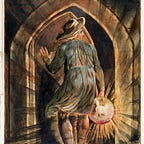Before telescopes and microscopes, imagination reigned supreme
Long before technologies like the telescope and microscope were invented human beings in early cultures relied on their imagination “to create” explanations for phenomenon they observed but didn’t immediately understand. Sometimes their imaginations lead them along a path to an accurate explanation and sometimes they did not. The two best examples are the way imagination allowed human beings to explain the space above them and the space within them.
From their beginnings in Sumer (now Iraq) around 3500 BC, the Mesopotamian people began to record observations of the world with extremely thorough numerical data.
Astronomy is a science that lends itself to the recording and study of observations: the vigorous notation of the motions of the stars, planets, and the moon are left on thousands of clay tablets created by scribes. Even today, astronomical periods identified by Mesopotamian scientists are widely used in Western calendars: the solar year, the lunar month, the seven-day week. Using this data humans developed arithmetical methods to compute the changing length of daylight in the course of the year and to predict the appearances and disappearances of the Moon and planets and eclipses of the Sun and Moon.
Babylonian astronomy recorded and studied celestial objects during the early history of Mesopotamia. These records can be found on Sumerian clay tablets, inscribed in cuneiform, dated from approximately 3500–3200 BC.
A great deal of astronomical mythology was handed down from the Sumerians creating images like this one of Orion in the stars. The earliest story concerning Orion was recorded by the Sumerians who ruled the southernmost region of Mesopotamia, or the land lying between the Tigris and Euphrates rivers.
To this urban civilization, the constellation represented their hero Gilgamesh, whose exploits were immortalized in the first surviving piece of heroic literature called the Epic of Gilgamesh. While records point to Gilgamesh being a historical king who ruled over the Sumerian city of Uruk in southern Mesopotamia sometime between 2700 and 2500 BC, the mythology describes Gilgamesh as a demigod possessing superhuman strength whose great accomplishments assured his divine status amongst the Mesopotamian people.
Different cultures and countries adopted their own constellations, some of which lasted into the early 20th century before today’s constellations were internationally recognized. Adoption of constellations has changed significantly over time. Many have changed in size or shape. Some became popular, only to drop into obscurity. Others were limited to single cultures or nations but all originated in the human imagination.
While medicine was “practiced” in Mesopotamia it was quite a bit less “scientific’ than the study of the heavens. The ancient Mesopotamians made little distinction between “medical science”, and magic. An understanding of human anatomy did not arrive for another millennium when writing enabled scientists and physicians to exchange knowledge and advance the subject.
The two places where it is most certain that the concept of writing was both conceived and developed independently are in ancient Sumer (in Mesopotamia), between 3400 and 3300 BC, and much later in Mesoamerica by 300 BC. Before writing systems, symptoms of disease were not recorded and it was difficult to pass on medical related knowledge. When a person in Mesopotamia became ill, physicians would use their imagination to prescribe both magical formulae as well as medicinal treatments.
The earliest medical prescriptions appear in Sumerian during the third Dynasty of Ur (c. 2112 BC — c. 2004 BC). The oldest Babylonian texts on medicine date back to the Old Babylonian period in the first half of the 2nd millennium BCE. The most extensive Babylonian medical text, however, is the Diagnostic Handbook written by the ummânū, or chief scholar, Esagil-kin-apli of Borsippa, during the reign of the Babylonian king Adad-apla-iddina (1069–1046 BCE).
Mental illnesses were well known in ancient Mesopotamia, where diseases and mental disorders were believed to be caused by specific deities rather than any concepts of physiology. Because hands symbolized control over a person, mental illnesses were known as “hands” of certain deities. One psychological illness was known as Qāt Ištar, meaning “Hand of Ishtar”. Others were known as “Hand of Shamash”, “Hand of the Ghost”, and “Hand of the God”.
Descriptions of these illnesses, however, are so vague that it’s usually impossible to determine which illnesses they correspond to in modern terminology. Mesopotamian doctors kept detailed records of their patients’ hallucinations and assigned spiritual meanings to them. A patient who hallucinated that he was seeing a dog was predicted to die; whereas, if he saw a gazelle, he would recover. The royal family of Elam was notorious for its members suffering from insanity.
While many of the basic tenants of medicine, such as bandaging and the collection of medical texts, began in Mesopotamia, human imagination appears to have offered more lasting insights when it was applied to planets rather than patients but that’s likely because human illness and death were much more acute than supernovae.
